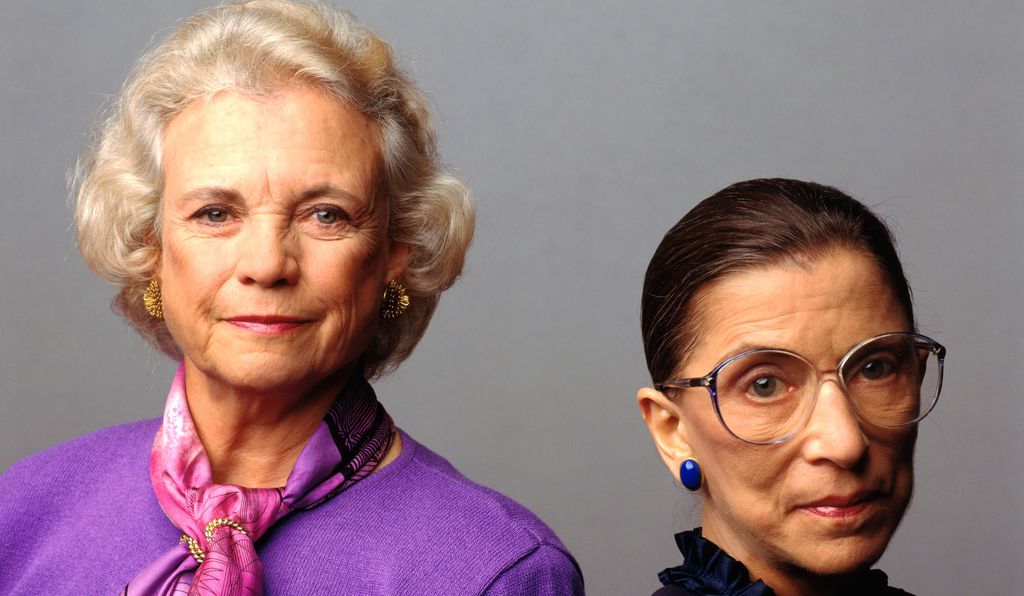
A lot of people will be eulogizing Ruth Bader Ginsburg over the next days and weeks, and rightfully so. She was a trailblazer who stood up for the rights of women (and gender equality as a whole), co-founding the ACLU’s Women’s Rights Project and later serving as its general counsel. She spent 27 years on the highest court in the United States, the second woman appointed to the Supreme Court since its founding. After Sandra Day O’Connor retired–the first woman appointed to SCOTUS–Justice Ginsburg was the only woman on the high court for 3.5 years. At that point she became a more vocal justice, reading her dissents from the bench when she deeply disagreed with the majority vote. Arguably, that was also when she started to become an icon.
With the death of RBG, I keep coming back to the phrase “end of an era.” I was a year old when Sandra Day O’Connor was appointed to the Supreme Court. As I grew up, I saw how she was singled out for being the only woman. It wasn’t necessarily negative, but it was always there. The attention weighed on Justice O’Connor: after more than a decade of being the sole woman, she was relieved when the Senate confirmed President Clinton’s nomination of Ruth Bader Ginsburg. It would be a further 16 years before another woman was nominated to the Supreme Court (Justice Sonia Sotomayor, followed by Justice Elena Kagan the next year). For the first 29 years of my life, there were no more than 2 women on the bench, doing their damndest to prove that women were able to “do the job of justice.” Justice O’Connor and Justice Ginsburg fought every day of their careers, on the bench and off, for female judges to be taken seriously. Whether that was for practical matters like a convenient women’s restroom in the Supreme Court, to equal pay for their work, to being denied work–or even interviews–due to gender, both women understood the symbolism behind their roles.
I was heartbroken when Sandra Day O’Connor retired. Not only a justice who strove for impartiality, she was conscious of all the eyes on her, gauging her suitability for the high court. She was deeply aware that her actions, and her rulings, would set precedent in a different way: whether women would be judged capable to handle the rigors of the Supreme Court. And yet, Justice O’Connor made the difficult decision to retire to be with her husband, who was suffering from Alzheimer’s disease. Her rationale was completely understandable, but losing her changed the make-up of the court (which had been settled for over a decade, a rarity in the history of the Supreme Court), and made women everywhere mourn the loss of representation that two female justices gave them.
After Sandra Day O’Connor retired, Ruth Bader Ginsburg picked up the mantle of sole woman on the Court, and began to morph into the Notorious RBG. Whether or not it was a role she wanted, it was a role that suited her. Having fought for women’s rights her whole life, she continued to do it on the bench. Like Justice O’Connor, RBG strove for impartiality, but had her own judicial philosophy, coloring both her opinions and her dissents. Her dissent in Ledbetter v. Goodyear helped inspire the Lilly Ledbetter Fair Pay Act law. Beyond the law, RBG even became a fashion icon of sorts. She inspired the other women of SCOTUS to embellish their robes, and entire websites are devoted to her jabots (the collar/necklace-like accessory over her robe robe) and their meanings. Though fashion may not seem judicial on the surface, many of her jabots reflected her mood. They also symbolized the democratic nature of the Court through the freedom of choosing what to wear–there is no “uniform” as such for Supreme Court Justices.
For me, the Supreme Court careers of RBG and Sandra Day O’Connor are intertwined. Growing up, they were the only hint that justice could be presided over by women–despite Blind Justice being a woman. With the loss of RBG, it feels as though one (albeit long) chapter of my life has ended–Sandra Day O’Connor retired when I was in my mid-20s, and RBG joined the court when I was 13. I’m grateful SCOTUS still has Justices Sotomayor and Kagan as role models, advocates, and voices for those who remain unheard. But I also recognize the burdens RBG and Sandra Day O’Connor carried are still carried by female justices at all levels of the judicial system. Perhaps, though, those burdens are lighter due to their untiring efforts.
Ruth Bader Ginsburg, zedek, zedek, tirdof.
-Katie Weidmann
Editor-in-Chief
Girl Museum Inc.
